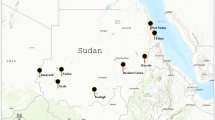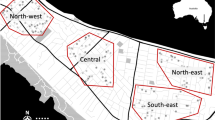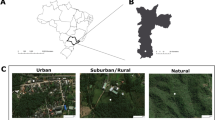Abstract
THE yellow fever mosquito, Aedes aegypti, is a complex species. Morphological, physiological, and behavioural variation is extensive and complex1–4. In the Rabai area near Mombasa, Kenya, three forms of A. aegypti can be distinguished5. A light coloured population breeds exclusively in water jars stored inside houses; this is referred to as the domestic form. In disturbed areas adjacent to villages (such as farmland), a form of varying darkness is found breeding in discarded containers or footholds cut in coconut palms; this is the peridomestic form. In tropical forests, an exclusively dark form is found breeding in tree-holes or occasionally rock-holes; this is the feral form. These forms are behaviourally distinct from one another5; and, even though they can be found in close proximity to each other, they are often also genetically distinct6 (W.J.T., L. E. Munstermann and J.R.P. in preparation). We present here a population genetic analysis of the domestic populations of A. aegypti in villages in the Rabai area. We conclude that the mosquito population in each village is a panmictic unit with no significant genetic substructuring ; that significant genetic differences exist between villages less than 2 km apart ; and that gene frequencies are temporally stable.
This is a preview of subscription content, access via your institution
Access options
Subscribe to this journal
Receive 51 print issues and online access
$199.00 per year
only $3.90 per issue
Buy this article
- Purchase on Springer Link
- Instant access to full article PDF
Prices may be subject to local taxes which are calculated during checkout
Similar content being viewed by others

References
Mattingly, P. F. Ann. trop. Med. Parasit. 51, 392 (1957).
McClelland, G. A. H. Trans. R. ent. Soc. Lond. 126, 239 (1974).
Gouck, H. K. Bull. Wld Hlth Org. 47, 680 (1972).
Crovello, T. J. & Hacker, C. S. Evolution 26, 185 (1972).
Tripis, M. & Hausermann, W. Bull. ent. Res. 65, 199 (1975).
Scott, J. A. & McClelland, G. A. H. Nature 256, 405 (1975).
Saul, S. H., Guptavanij, P. & Craig, G. B. Ann. ent. Soc. Am. 69, 73 (1976).
Tabachnick, W. J. & Powell, J. R. Genetics 83, 75 (1976).
Wright, S. Ann. Eugen. 15, 324 (1951).
McDonald, P. T. J. med. Ent. 14, 49 (1977).
Pal, R. & Whitten, M. J. (ed.) The Use of Genetics in Insect Control (Elsevier North Holland, Amsterdam, 1975).
Lorimer, N., Lounibos, L. & Petersen, J. L. J. econ. Ent. 69, 405 (1976).
Levene, H. Ann. Math. Stat. 20, 91 (1949).
Author information
Authors and Affiliations
Rights and permissions
About this article
Cite this article
TABACHNICK, W., POWELL, J. Genetic structure of the East African domestic populations of Aedes aegypti. Nature 272, 535–537 (1978). https://doi.org/10.1038/272535a0
Received:
Accepted:
Issue Date:
DOI: https://doi.org/10.1038/272535a0
This article is cited by
-
Genetic deviation in geographically close populations of the dengue vector Aedes aegypti (Diptera: Culicidae): influence of environmental barriers in South India
Parasitology Research (2016)
-
Field evaluation of natural human odours and the biogent-synthetic lure in trapping Aedes aegypti, vector of dengue and chikungunya viruses in Kenya
Parasites & Vectors (2014)
-
Geographic Variation in Attraction to Human Odor Compounds by Aedes aegypti Mosquitoes (Diptera: Culicidae): A Laboratory Study
Journal of Chemical Ecology (2006)
-
Evolutionary cytogenetics of Aedine mosquitoes
Genetica (1980)
Comments
By submitting a comment you agree to abide by our Terms and Community Guidelines. If you find something abusive or that does not comply with our terms or guidelines please flag it as inappropriate.


